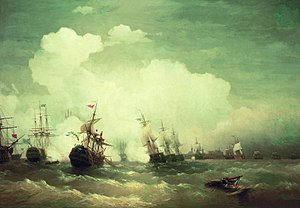Palimede incident
| Palimede incident | |||||||
|---|---|---|---|---|---|---|---|
| Part of Kindred Wars | |||||||
 Battle of Palimede island by Pelaxian painter, Nino Godoy | |||||||
| |||||||
| Belligerents | |||||||
|
House Lian House Kou | Carto-Pelaxian Commonwealth | ||||||
| Commanders and leaders | |||||||
| Admiral Smaragdus | Don Elver Galarga | ||||||
| Strength | |||||||
|
10,000 men 30 ships |
13,000 40 ships | ||||||
| Casualties and losses | |||||||
| thousands | hundreds | ||||||
The Palimede incident was a battle between a Qian slaver fleet and forces of the Carto-Pelaxian Commonwealth. By the late 1780's the volume of slaves acquired by the Carto-Pelaxian Commonwealth began to decline steeply due to labor reforms favoring the use of indentured workers and serfs from Vallos which represented a readily available pool of workers at cheaper rates. Certain powerful slaving interests at the Qian court at this point advocated a policy of armed coercion against the weakening Commonwealth. Without waiting for imperial assent, the noble houses of Kou and Lian which relied on the slave trade around Vallos assembled a fleet of their own and augmented it with Loa and Muslim privateers. Their plan was to occupy some or all of the Jusonia Islands and threaten the Carto-Pelaxian capital of Albalitor unless the new labor reforms were withdrawn by the Commonwealth's government and an indemnity was paid. During the Palimede incident of 1783 this slaver coalition was ultimately repulsed in both land and sea battles by the Carto-Pelaxians, one of the last notable military victories of the crumbling Commonwealth. Albeit unsanctioned by Qian imperial authorities, the incident soured relations between Daxia and one of its most important trade partners; the sale of slaves to the Commonwealth all but dwindled into nothingness as that government put new legal roadblocks on the flesh trade and the Qian court destroyed the participating noble houses in retaliation for their insubordination.
Background
The slave trade along the southern route was still incredibly lucrative going into the 18th century, both the Carto-Pelaxian Commonwealth and the Imperium were reliable buyers. Independent Daxian slaving cartels owned by noble houses dominated most of the route east of Truk and into the Kindreds; the most prominent of these houses were House Lian and House Kou. The continued prosperity and profits of these slaving actors would eventually be threatened by political currents from within the Commonwealth itself as several political groupings in Parliament backed by the local curia put forth proposals that if implemented would end the practice of slavery in the Commonwealth. The Qian ambassador to Carto-Pelaxia, an habitual ally of slaver interests, quickly relayed the new developments to his masters across the Cathay. The reaction of the Qian court was mixed, Emperor Chanzui and many of his ministers were of a mind that the issue could be addressed politically and in any case more than slaves were traded with the Commonwealth. The noble houses of Kou and Lian on the other hand were outraged at the prospect of lost revenues but their entreaties for the sending of a Qian fleet to intimidate the Carto-Pelaxian parliament were rejected out of hand. Undeterred, Prince Kou and Prince Lian put forth a plan in motion to put a stop to anti-slavery legislation on their own. Under the pretext of fighting off the incursions of Loa pirates, they assembled a fleet of thirty ships in Peratra and raised a small army of 7,000 mercenaries which would later be augmented by some 3,000 pirates.
Opposing forces
Slaver alliance
House Kou and House Lian assembled a strong naval fleet composed of 30 ships of which eleven were ships of the line, ten were frigates and the rest were a combination of smaller galleys, frigates and slaver hold ships retrofitted to carry troops. The fleet was led by a mercenary admiral named Smaragdus, some sources place him as an ethnic Caphirian and others as an Istroyan. The land forces were composed by an elite core of two thousand household troops equipped by Princes Kou and Lian, five thousand mercenaries recruited from Lakdu, Truk and Peratra and finally some three thousand Loa and Almadarian pirates and corsairs were enticed to join the expedition later on by the prospect of looting.
Carto-Pelaxian Commonwealth
The Commonwealth's Kindreds fleet during the 17th century was a much diminished force, it had a dedicated force of forty ships of which at least twelve were well armed ships of the line, fifteen frigates and an assortment of galleys, sloops, cutters and corvettes. While both opposing fleets had an almost near parity of ships of the line, the Carto-Pelaxians had the advantage in training and discipline; Smaragdus's fleet was crewed exclusively by corsairs who were not known for discipline under fire.
Occupation of Palimede
The combined slaver fleet under Smaragdus left anchor in late August, picking up supplies on Truk in early September. Smaragdus's next stop was at Aetialo, Loa Empire to recruit more troops, the majority of which were from the kingdom of Isuekende. Parts of the fleet tried to pressure Smaragdus to raid the [coast] in the Krasoa Islands, but such attempts were crushed by Smaragdus with the Kou household soldiers. The appearance of such a sizable slaver fleet in the Kindreds raised alarms, even the biggest slave ship convoys did not surpass fifteen ships; Albalitor gave orders to recall the Kindreds fleet but as it was engaged in other battles it would take some time. Smaragdus was counting on speed and the element of surprise to gain the advantage over the Carto-Pelaxians.